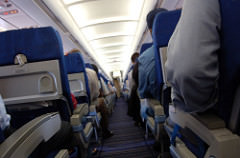16.1 案例研究:贵机构的运输系统
章节大纲
-
Case Study: Flight Risk
::案例研究:飞行风险Nineteen-year-old Steve is about to take his first plane flight. Shortly after he boards the plane and sits down, a man in his late sixties sits next to him in the aisle seat. About half an hour after the plane takes off, the pilot announces that she is turning the seat belt light off, and that it is safe to move around the cabin.
::19岁的Steve正准备搭乘他的第一架飞机。 在他登机和坐下后不久,一个满六十岁的男子坐在他旁边的过道座位上。 飞机起飞大约半小时后,飞行员宣布她正在关上安全带灯,并且可以安全地在机舱周围移动。The man in the aisle seat — who has introduced himself to Steve as Jim — immediately unbuckles his seat belt and paces up and down the aisle a few times before returning to his seat. After about 45 minutes, Jim gets up again, walks some more, then sits back down and does some foot and leg exercises. After the third time Jim gets up and paces the aisles, Steve asks him whether he is walking so much to accumulate steps on a pedometer or fitness tracking device. Jim laughs and says no. He is actually trying to do something even more important for his health — prevent a blood clot from forming in his legs.
::坐在过道座上的人——他把自己介绍给史蒂夫,作为吉姆——立即解开安全带,在回到座位之前,在过道上和下行走几次,在45分钟后,吉姆再次站起来,多走几步,然后坐下来做一些脚和腿的锻炼。在第三次吉姆站起来并加快过道后,史蒂夫问他,他是否走得那么远,以在仪表或健身跟踪装置上累积脚步。吉姆笑并说不。他实际上试图做一些对其健康更为重要的事情,防止腿部出现血块。Jim explains that he has a chronic condition: heart failure. Although it sounds scary, his condition is currently well-managed, and he is able to lead a relatively normal lifestyle. However, it does put him at risk of developing other serious health conditions, such as deep vein thrombosis (DVT), which is when a blood clot occurs in the deep veins, usually in the legs. Air travel — and other situations where a person has to sit for a long period of time — increases the risk of DVT. Jim’s doctor said that he is healthy enough to fly, but that he should walk frequently and do leg exercises to help avoid a blood clot.
::Jim解释说,他患有慢性病:心脏病。虽然听起来很可怕,但目前他的状况管理良好,他能够过上相对正常的生活。 但是,这确实使他面临发展其他严重健康状况的风险,比如深血管血栓症(DVT ) , 即血液血栓症发生在心血管,通常是腿部。 空中旅行 — — 以及一个人必须长时间坐坐的其他情况 — — 增加了DVT的风险。 Jim的医生说,他身体健康,可以飞行,但他应该经常走路,做腿锻炼,以避免血块。As you read this chapter, you will learn about the heart, blood vessels, and blood that make up the cardiovascular system, as well as disorders of the cardiovascular system, such as heart failure. At the end of the chapter you will learn more about why DVT occurs, why Jim has to take extra precautions when he flies, and what can be done to lower the risk of DVT and its potentially deadly consequences.
::正如你读了本章,你会了解心血管系统的心脏、血管和血液,以及心血管系统的疾病,例如心脏衰竭。 在本章结尾,你会更多地了解为什么DVT会发生,为什么吉姆飞行时必须额外采取预防措施,以及可以做些什么来降低DVT的风险及其潜在的致命后果。Chapter Overview: Cardiovascular System
::章节概览:心血管系统In this chapter, you will learn about the cardiovascular system, which transports substances throughout the body. Specifically, you will learn about:
::在本章中,您将了解心血管系统,它在整个身体中传递物质。具体地说,您将了解:-
The major components of the cardiovascular system: the heart, blood vessels, and blood
::心血管系统的主要组成部分:心脏、血管和血液 -
The functions of the cardiovascular system, including transporting needed substances (such as oxygen and nutrients) to the cells of the body, and picking up waste products
::心血管系统功能,包括将所需物质(如氧和营养物质)运至身体细胞,以及拾取废物产品 -
How blood is oxygenated through the pulmonary circulation, which transports blood between the heart and lungs
::血液如何在肺循环中氧化 肺循环中血液在心脏和肺之间传播 -
How blood is circulated throughout the body through the systemic circulation
::血液如何通过系统性循环在整个身体中传播 -
The components of blood — including plasma, red blood cells, white blood cells, and platelets — and their specific functions
::血液组成部分——包括等血浆、红血细胞、白血细胞和小血小板——及其具体功能 -
Types of blood vessels — including arteries, veins, and capillaries — and their functions, similarities, and differences
::血管种类——包括动脉、血管、血管和血管——及其功能、相似性和差异 -
The structure of the heart, how it pumps blood, and how contractions of the heart are controlled
::心脏的结构 如何抽血 如何控制心脏的收缩 -
What blood pressure is and how it is regulated
::血压是什么? 如何调节? -
Blood disorders, including anemia, HIV, and leukemia
::血液疾病,包括贫血、艾滋病毒和白血病 -
Cardiovascular diseases
(i
ncluding heart attack, stroke, and angina), and the risk factors and precursors — such as high blood pressure and atherosclerosis —
that
contribute to them
::心血管疾病(包括心脏病、中风和心血管疾病),以及助长这些疾病的危险因素和先质,如高血压和无神社球硬化等
As you read the chapter, think about the following questions:
::当你读到该章时,请考虑以下问题:1. What is heart failure? Why do you think it increases the risk of DVT?
::1. 什么是心脏病?你为什么认为它会增加DVT的风险?2. What is a blood clot? What are possible health consequences of blood clots?
::2. 什么是血凝块?血凝块可能对健康产生什么后果?3. Why do you think sitting for long periods of time increases the risk of DVT? Why does walking and exercising the legs help reduce this risk?
::3. 为什么你认为长时间坐坐会增加DVT的风险? 为什么步行和锻炼腿能帮助降低这种风险? -
The major components of the cardiovascular system: the heart, blood vessels, and blood
